South Asia Economic Focus, Fall 2018: Budget CrunchAmid a turbulent international environment, South Asia is expected to remain the fastest-growing region in the world. Growth in Bangladesh will be driven by consumption and public investment. In Bhutan, growth is expected to accelerate with the commissioning of two major hydropower projects. Growth in India firms up prompted by the adoption of the Goods and Services Tax and the recapitalization of banks. Maldives is projected to grow strongly based on dynamism in construction and tourism. Economic activity in Nepal is set to grow over the medium term while Sri Lanka’s economic growth will recover following 2017’s weather disruptions. The report highlights how growth performance is anchored on domestic consumption rather than private investment or exports. Author: World Bank Year: 2018 Download Tags: Bangladesh, Bhutan, Economic Growth, Exports 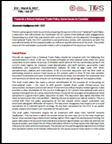 Trade Intelligence for the Private Sector Vol 17 – Towards a Robust National Trade PolicyThis paper provides an overview of the Ceylon Chamber of Commerce's (CCC) comments on the draft national trade policy for Sri Lanka prepared by Sri Lanka's Ministry of Development Strategies and International Trade. CCC's review focuses on ten key issues—trade liberalization; multilateral trading agreements, global value chains, global production networks; revenue considerations; innovation and technology upgrades; institutional reforms; regulatory reforms; government support for the private sector; rise of protectionism; digital trade and e-commerce; and future of existing bilateral and regional agreements. The Chamber puts forward that alongside a refocusing of Sri Lanka's trade policies toward international trade, new trade policy should tackle issues that arose from the current framework and be aligned with policies and institutions. It highlights the need for a forward thinking national trade policy that will improve Sri Lanka's competitiveness, and encompass interests of today's private sector as well as tomorrow's businesses and entrepreneurs. Author: CCC Economic Intelligence Unit Year: 2017 Download Tags: Sri Lanka, Economic Growth, Trade Competitiveness of South Asia’s Container Ports: A Comprehensive Assessment of Performance, Drivers, and CostsAs a result of inefficiencies in South Asia’s container ports, the average cost of exporting or importing a container in the region is more than double that in East Asia. Better port logistics could help increase trade, diversify exports, attract more foreign direct investment, and spur economic growth. As container traffic continues to grow in South Asia, the best way to improve port performance is by increasing productivity. This report examines the performance of the 14 largest container ports in the region, identifying key drivers of port performance and examining differences in performance across ports. Author: Matías Herrera Dappe and Ancor Suárez-Alemán Year: 2016 Download Tags: Customs, Economic Growth, FDI, Infrastructure, Investment, South Asia, Trade, WB South Asia Economic Focus, Fall 2016: Investment Reality CheckSouth Asia continues on a path of gradual acceleration in 2016, led by a solid India. However, amid the resilience to external headwinds, including China’s slowdown and uncertainty surrounding monetary policy in advanced economies, South Asia is starting to feel the effect of slowing remittance flows or waning oil price dividends. Against this backdrop, this World Bank publication forecasts growth for the region at 7.1% in 2016, with its medium-term performance strongly dependent on investment and export turnout. India is set to grow at 7.6% in 2016, with the same speed as in 2015, but may increase its pace again in 2017 to 7.7%. The report highlights how private investment is a key future growth driver across South Asia that could help further boost the pace of economic activity. Author: World Bank Year: 2016 Download Tags: India, South Asia, Investment, Economic Growth, WB, Export The Little Data Book 2016The Little Data Book 2016 offers a quick reference of World Development Indicators 2016, presenting the latest available data for World Bank member countries and other economies in 214 tables. Regional and income group aggregates are also covered in the 12 summary tables, including South Asia. The book includes selected indicators used to monitor progress toward the Sustainable Development Goals. Author: World Bank Year: 2016 Download Tags: Sustainability, South Asia, Economic Growth 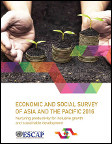 Economic and Social Survey of Asia and the Pacific 2016The 2016 edition of UNESCAP’s Economic and Social Survey of Asia and the Pacific encourages the region to rethink its development strategy. As 2016 marks the beginning of the 2030 Agenda for Sustainable development, the period is also characterized by an outlook clouded by uncertainty, with growth expected to plateau at about 5% in 2016 and 2017. Exports bound for developed economies continue to move sluggishly and domestic demand remain moderate. Thus, to bolster economic growth, the Survey recommends adopting a development model that raises domestic and regional demand. Along with active labor market policies and greater social protection, regional economic cooperation and integration--in areas covering capital markets, intraregional trade, infrastructure development, and energy and information and communications technology (ICT) connectivity--can be an important avenue for boosting domestic and regional demand. Author: United Nations Economic and Social Commission for Asia and the Pacific Year: 2016 Download Tags: Economic Growth, Regional Cooperation, ICT, Energy Asian Development Outlook 2016: Asia’s Potential GrowthThe Asian Development Outlook 2016 forecasts 5.7% growth for developing Asia in 2016 and 2017. It projects that South Asia will post the most rapid growth in developing Asia, with growth in the subregion accelerating to 7% in 2015, and will accelerate further to 7.3% in 2017 after a slight dip to 6.9% in 2016. India's growth is expected to undergo a slight slowdown to 7.4% in 2016 as exports decline and both public and private investment slows, but rebound to 7.8% in 2017 as the business environment improves, and exports and investment recover. Bangladesh will also see continued moderate growth, resulting from sustained progress toward macroeconomic and structural reform. Author: Asian Development Bank Year: 2016 Download Tags: Asia, India, Bangladesh, Economic Growth, Development, ADB 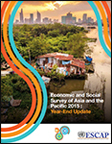 Economic and Social Survey of Asia and the Pacific 2015: Year-end UpdateThis year-end update revises economic growth in developing economies in Asia and the Pacific to 4.5% in 2015, from earlier projections of 4.9%, and updates the economic growth forecast for 2016 to 5%, from 5.2%. In most developing economies, including South and South West Asia, private consumption will lead to a slight pick-up in economic growth in 2016, amid gradual fiscal tightening and weak exports. With less robust growth compared to the years before and immediately after the global financial and economic crisis that started in 2008, the report highlights a need to tap into domestic and regional sources of demand—alternatives to dependence on external demand—including boosting investment in infrastructure, small and medium-sized enterprises, and the agricultural sector. Promotion of labor participation among the youth and the female population in South and South West Asia is also encouraged, since evidence has shown that improving their job opportunities matters for economic growth. Author: UNESCAP Year: 2016 Download Tags: Economic Growth, Gender, Infrastructure, UNESCAP Trade in Services: The Most Dynamic Segment of International TradeThe World Trade Organization (WTO) marks its 20th anniversary with a series of brochures to assist understanding of specific WTO agreements. This publication focuses on the WTO General Agreement on Trade in Services (GATS), which provides the legal ground rules for international trade in services, allowing WTO members the flexibility to open their markets to foreign competition to the extent of their choosing. GATS entered into force in 1995 and remains the only set of multilateral rules covering international trade in services. This brochures provides an overview of the different modes by which services are traded, commitments taken by WTO members, and developments enhancing GATS commitments and information on trade in services. Author: World Trade Organization Year: 2015 Download Tags: Services, Trade Facilitation, Economic Growth, WTO Sri Lanka: Building on SuccessOver the years, the Asian Development Bank (ADB) and its many partners in Sri Lanka have worked together to realize the goal of changing the country’s status from low to middle income. With Sri Lanka moving toward becoming an upper middle-income country in a few years, challenges lie on the road ahead. This publication provides an overview of recent ADB support toward Sri Lanka's development in diverse areas including transport, energy and education, and discusses how the Government of Sri Lanka and ADB will transition their partnership to push the country to the next level of prosperity. Author: Asian Development Bank Year: 2015 Download Tags: Sri Lanka, Transport, Ports, Development, Economic Growth 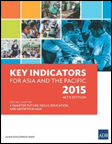 Key Indicators for Asia and the Pacific 2015The Key Indicators for Asia and the Pacific 2015 includes up-to-date available indicators for the 48 regional members of the Asian Development Bank, including numbers on energy, trade, transport, and tourism. Key trends noted in 2014 include the rising volume of intraregional exports globally, due to robust economic growth and expanding regional networks. For Asia and Pacific economies, primary source for merchandise imports was the region itself with a 49.7% share. In energy consumption, Asia and the Pacific now consumes more than 40% of the world's electricity, with the People's Republic of China and India accounting for nearly 70% of the region's output. This 46th edition of Key Indicators also includes a special chapter on skills, education, and growth in Asia, and emphasizes the need to focus on quality and ensure that the workforce has the skills to take the region through economic transition to prosperity. Author: Asian Development Bank Year: 2015 Download Tags: Economic Growth, Energy, Trade, Transport, India Asian Development Outlook 2015 Update: Enabling Women, Energizing AsiaThis Update revises growth forecast for the Asia and the Pacific region down to 5.8% in 2015 and 6.0% in 2016, with delayed recovery in major industrial economies and slowing investment prospects in India and the People's Republic of China. Growth acceleration in South Asia has also been more modest than forecast - now projected at 6.9% in 2015, below the 7.2% March forecast, but up from 6.7% in 2014, and forecast to rise further to 7.3% in 2016. The need to energize growth in the region calls for avenues to unlock untapped resources, including narrowing gender gaps in the labor market. In Bangladesh, the increase in women's participation in the workforce has not only enhanced their bargaining power at home, but improved health and education options for the family. Author: Asian Development Bank Year: 2015 Download Tags: Asia-Pacific, Economic Growth, ADB 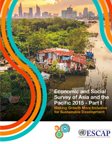 Economic and Social Survey of Asia and the Pacific 2015The 2015 edition of ESCAP’s Economic and Social Survey of Asia and the Pacific highlights inclusive growth as a prerequisite for meeting the Millennium Development Goals and critical for effective implementation of the sustainable development agenda post-2015. It also contains proposals to improve the pattern of public expenditures and increase access to financial services. Economic growth in South and South-West Asia increased in 2014, led by stronger macroeconomic performance in India, but remained far below its pre-crisis pace. While the near-term outlook is optimistic and conditional on continued domestic reform in large economies, limited intraregional trade within the sub-region could limit positive spillovers into relatively smaller economies. A key reform area is broadening the tax base and stemming of tax evasion to lower public borrowing and help address severe power shortages. Author: United Nations Economic and Social Commission for Asia and the Pacific Year: 2015 Download Tags: Asia-Pacific, Economic Growth, South Asia Asian Development Outlook 2015 Supplement: Growth Prospects Soften for Developing AsiaThis Supplement revises growth projections for developing Asia published in the Asian Development Outlook (ADO) 2015 in March, as slower-than-expected recovery in the United States and moderating growth in the People’s Republic of China weigh on the region’s prospects. Economic outlook for South Asia is stronger growth in the subregion as a whole in 2015 than forecast in ADO 2015, now bumped up slightly to 7.3% from 7.2%. The projection for 2016 remains the same at 7.6%. By individual countries, stronger growth is estimated for Bangladesh in FY2015, but slower growth is projected for the Maldives and earthquake-struck Nepal. Author: Asian Development Bank Year: 2015 Download Tags: Development, Economic Growth, South Asia Aid for Trade in Asia and the Pacific 2015This Asian Development Bank report explores the potential of the digital economy to improve the inclusiveness of Aid for Trade (AfT). It uses the review of AfT as a springboard to explore new ways of thinking and how to address issues such as high trade costs in some regions. In particular, it considers how to build on information and communications technology and infrastructure connectivity from established AfT spending. The report also highlights the experience of exporters to illustrate the unique challenges and opportunities for trade-driven growth in a region where high trade costs are structural. Author: Alisa Di Caprio and Kati Suominen Year: 2015 Download Tags: ICT, Infrastructure, Trade, ADB, Asia-Pacific, Exports, Economic Growth, Trade Facilitation Economic and Social Survey for Asia and the Pacific: Part 2 – Balancing the Three Dimensions of Sustainable Development: From Integration to Implementation This theme study outlines a conceptual framework, a set of strategies and policy options, and offers perspectives on institutional frameworks for integrating the three dimensions of sustainable development – economic growth, social progress and environmental protection. Regional cooperation is critical in maximizing opportunities for building synergies between the three dimensions. Initiatives at the regional level should consider establishing a regional road map, supporting regional economic integration initiatives, and strengthening regional platforms, including the United Nations and the multilateral system. Author: United Nations Economic and Social Commission for Asia and the Pacific Year: 2015 Download Tags: Asia-Pacific, Economic Integration, Regional Cooperation, Economic Growth, Environment, Sustainability, UNESCAP 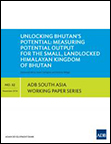 Unlocking Bhutan’s Potential: Measuring Potential Output for the Small, Landlocked Himalayan Kingdom of Bhutan The hydropower sector has driven Bhutan's economic growth in the past two decades with growth rates averaging 7.9%. Yet, the economy has not been invulnerable to market fluctuations and external shocks. This ADB South Asia Working Paper analyzes how Bhutan can create sustainable and inclusive growth, alongside the continuous expansion of its hydropower industry. It examines how certain policies can impact Bhutan's potential growth over 2013–2030. Results show that higher investment in education, health, and efforts to diversify its economic base—including enhancement of new industries with linkages to regional and global value chains—can further drive economic growth and improve the country's living standards. Author: Sabyasachi Mitra, Sarah Carrington, and Anthony Baluga Year: 2014 Download Tags: Bhutan, Energy, Economics, Hydropower, ADB, South Asia, Sustainability, Global Value Chains, Economic Growth World Trade Report 2014 – Trade and Development: Recent Trends and the Role of the WTOThis annual publication highlights the relationship between trade and development, including changes since the start of the millennium. It identifies four key trends that altered the way trade affects development outcomes – accelerated economic growth in developing countries, expansion of global value chains, increase in agricultural and natural resource prices, and global nature of macroeconomic shocks. This report also explores how these trends have reshaped the role of trade in facilitating development and how recent development gains allow developing countries to adapt and mitigate risks. Author: World Trade Organization Year: 2014 Download Tags: WTO, Global Value Chains, Trade, Economic Growth, Agriculture, Trade Facilitation, Development, Bangladesh, Bhutan, India, Maldives, Nepal, South Asia, Sri Lanka 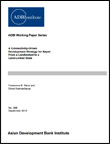 A Connectivity-Driven Development Strategy for Nepal: From a Landlocked to a Land-Linked StateTransforming Nepal from a landlocked into a land-linked state, the authors argue, could be key to unlocking the country's much-awaited growth. With its strategic location between India and the People's Republic of China, a connectivity-driven development strategy could energize Nepal's lackluster post-conflict economic performance. Further, Nepal implements a multi-track approach to promoting regional cooperation and integration in connectivity with its neighbors, reinforced through participation in South Asian Association for Regional Cooperation, Bay of Bengal Initiative for Multi-Sectoral Technical and Economic Cooperation, and South Asia Subregional Economic Cooperation. By identifying ten priority projects that could further boost Nepal's connectivity, the paper also discusses how strengthening Nepal's transport, energy, and trade links could benefit the region. However, the authors also warn against “internal threats” to Nepal's development—corruption and the country's difficult political situation. Author: Pradumna B. Rana and Binod Karmacharya Year: 2014 Download Tags: Nepal, Economic Corridor, Regional Trade, Connectivity, Development, Economic Growth, SASEC, India, Regional Cooperation, Regional Integration, SAARC, BIMSTEC, Transport, Energy, Trade 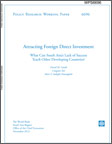 Attracting Foreign Direct Investment: What Can South Asia's Lack of Success Teach other Developing Countries?Despite South Asian nations experiencing increased foreign direct investment (FDI) flows over the past decade by gaining a large share of cross border investments, FDI inflows in South Asian countries still remain the lowest relative to gross domestic product (GDP) among developing country regions. This paper uses an empirical model that accounts for possible trends in convergence in the ratio of FDI to GDP between countries and cross-sectional data for 78 countries from 2000 to 2011. In examining the historical patterns of South Asia’s FDI and its connection with the policy environment, policymakers can identify constraints to FDI and boost potential for broad-based growth. Author: David M. Gould, Congyan Tan and Amir S. Sadeghi Emamgholi Year: 2013 Download Tags: South Asia, Trade Policy, FDI, GDP, Investment, Governance, Transparency, Economic Growth, Financial Sector, Regional Cooperation, Trade Climate Action South Asia: Information Update No. 1 (Development in an Era of Accentuated Climate Risks)To steer South Asian economies toward green, low-carbon, and climate-resilient development and for these to take hold in South Asia, the countries need (i) better understanding and greater public awareness of the implications of climate change, (ii) climate risks screening and decision-support tools for identifying actions and managing results, (iii) improved governance and institutional capacities to take necessary actions to manage climate change impacts, (iv) funding sources for such actions, and (v) projects and programs demonstrating positive results that can be scaled up. Author: Asian Development Bank Year: 2012 Download Tags: Economics, Climate, Climate Change, Environment, Sustainability, South Asia, Development, Economic Growth, ADB |



